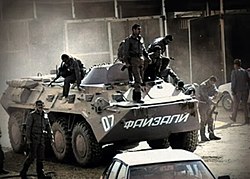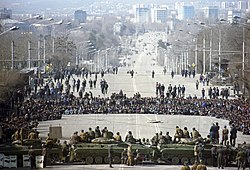Tajikistani Civil War
| Tajikistani Civil War | |||||||
|---|---|---|---|---|---|---|---|
| Part of the post-Soviet conflicts and spillover of the Afghan Civil War (1992–1996) | |||||||
 Spetsnaz soldiers of the 15th Independent Special Forces Brigade during the Civil War | |||||||
| |||||||
| Belligerents | |||||||
|
|
| ||||||
| Commanders and leaders | |||||||
| Hassan Abaza |
| ||||||
| Strength | |||||||
|
| Estimated around 50,000–70,000 | ||||||
| Casualties and losses | |||||||
| Unknown | Unknown | ||||||
|
20,000[10]–150,000 killed[11] 1.2 million displaced | |||||||
|
| |||||||
The Tajikistani Civil War,
The main zone of conflict was in the country's south, although disturbances occurred nationwide.[14][15] The civil war was at its peak during its first year and continued for five years, devastating the country.[14][16] An estimated 20,000[10] to 150,000[11] people were killed in the conflict, and about 10 to 20 percent of the population of Tajikistan were internally displaced.[13] On 27 June 1997, Tajikistan president Emomali Rahmon, United Tajik Opposition (UTO) leader Sayid Abdulloh Nuri and Special Representative of the United Nations Secretary-General Gerd Merrem signed the General Agreement on the Establishment of Peace and National Accord in Tajikistan and the Moscow Protocol in Moscow, Russia, ending the war.[17]
History
Background

There were numerous causes of civil war in Tajikistan, such as economic hardship, communal way of life of Tajiki people and their high religiosity. Under Soviet President Mikhail Gorbachev's 'Perestroika' policies, a Muslim-Democratic movement began to emerge in Tajiki SSR. The backbone of opposition were Party of Tajikistan Muslim Resurrection, Democratic party of Tajikistan and some other movements. The fight between the former communist elite and opposition shifted from the political sphere to an ethnic and clan based one.
Tensions began in the spring of 1992 after opposition members took to the streets in demonstrations against the results of the 1991 presidential election. President Rahmon Nabiyev and Speaker of the Supreme Soviet Safarali Kenjayev orchestrated the dispersal of weapons to pro-government militias, while the opposition turned to mujahideen in Afghanistan for military aid.
Conflict (1992–1993)
Fighting broke out on 5 May 1992 between old-guard supporters of the government and a loosely organized opposition composed of ethnic and regional groups from the
With the aid of the Russian military and
The height of hostilities occurred from 1992 to 1993 and pitted Kulobi militias against an array of groups, including militants from the
Continued conflict (1993–1997)
In Afghanistan, the opposition reorganized and rearmed with the aid of the
Other combatants and armed bands that flourished in this civil chaos simply reflected the breakdown of central authority rather than loyalty to a political faction. In response to the violence the United Nations Mission of Observers in Tajikistan was deployed. Most fighting in the early part of the war occurred in the southern part of the country, but by 1996 the rebels were battling Russian troops in the capital city of Dushanbe.
Armistice and aftermath

A United Nations-sponsored armistice finally ended the war in 1997. This was in part fostered by the Inter-Tajik Dialogue, a Track II diplomacy initiative in which the main players were brought together by international actors, namely the United States and Russia. The peace agreement eliminated the Leninabad region (Khujand) from power. Presidential elections were held on 6 November 1999.
The
By the end of the war, Tajikistan was in a state of complete devastation. Around 1.2 million people were refugees inside and outside the country. Tajikistan's physical infrastructure, government services and economy were in disarray and much of the population was surviving on subsistence handouts from international aid organizations. The United Nations established a Mission of Observers in December 1994, maintaining peace negotiations until the warring sides signed a comprehensive peace agreement in 1997.[29]
Targeting of journalists
Journalists were particularly targeted for assassination and at least 40 Tajik journalists were killed.
Gallery
-
Satellite photograph of Tajikistan
-
Destroyed turret of a T-72
-
Tajikistan factions in civil war: Leading clans: Northern Sughd Region (red), Southern Khatlon Region (blue), Pamir (Gorno-Badakhshan) (green)
-
The most important cities involved in the conflict. 1)Kulob
See also
- Tajikistan-Uzbekistan relations
- United Nations Mission of Observers in Tajikistan
- 1992 Tajikistan protests
- Post-Soviet conflicts
- List of civil wars
References
- romanized: Jangi shahrvandiyi Tojikiston / Çangi shahrvandiji Toçikiston; Russian: Гражданская война в Таджикистане
- ^ "Tajikistan: President Meets With Popular Front Commanders". Radio Liberty Archives. 9 July 1997. Archived from the original on 12 October 2017. Retrieved 23 June 2017.
- ^ "Американцы боятся белорусских танков. Белоруссия американских санкций не боится" [Americans are afraid of Belarusian tanks. Belarus is not afraid of American sanctions]. Lenta.ru (in Russian). 1 March 2002. Archived from the original on 20 November 2021.
- ISBN 9781845112936. Archivedfrom the original on 16 January 2016. Retrieved 17 December 2014.
- ^ Inside Al Qaeda: global network of terror, by Rohan Gunaratna, pg. 169
- ^ "Iran dismisses Tajik civil war claims as attempt to damage ties". Reuters. Retrieved 10 August 2017.
- ^ "A Thaw Between Tajikistan and Iran, But Challenges Remain". Jamestown. Retrieved 10 July 2019.
Fearing a continuity of Soviet-era policies, Iran supported the Islamic and nationalist opposition during the civil war.
- ^ Abdulfattoh, Shafiev (February 2016). "Iran and Tajikistan: A Story of Love and Hate" (PDF). Central Asia Policy Brief. 34.
At the end of 1992, Tajikistan entered into a bloody civil war. Tehran gave refuge and support to the leaders of the Democratic-Islamic coalition of the Tajik opposition, and was therefore considered to be a pro-Islamic actor. However, it also contributed a critical role in helping peace discussions: Tehran hosted several rounds of the Tajik peace negotiations in 1994, 1995, and 1997, bringing both sides to the discussion table. President Rahmon paid an official visit to Tehran in 1995 and opened an embassy there. But seen from Dushanbe, Moscow was a more reliable ally than Tehran, and any kind of pan-Persian nationalism was rapidly shut down by the authorities.
- ^ Ahmad, Majidyar. "Tajikistan Accuses Iran of Sponsoring Terrorism, Restricts Iranian Organizations' Activities". Middle East Institute. Retrieved 9 August 2017.
Tajikistan has accused Iran of having played a subversive role in the country's civil war in the 1990s by sending terrorists to the Central Asian republic, the latest sign of deteriorating relations between the two countries.
- ^ "Боевые действия на таджикско-афганской границе (начало 1990–х гг.)". Archived from the original on 13 November 2020. Retrieved 5 May 2020.
- ^ a b Pannier, Bruce (26 June 2017). "The Many Agents Of Tajikistan's Path To Peace". Radio Liberty. Archived from the original on 3 July 2017. Retrieved 4 July 2017.
- ^ a b "The Peace Deal That Ended Tajikistan's Bloody Civil War". RadioFreeEurope/RadioLiberty. 27 June 2021. Archived from the original on 31 August 2022. Retrieved 31 August 2022.
- ^ Dubovitsky, Viktor (February 2003). "Features of the ethnic and confessional situation in the Republic of Tajikistan" (in Russian). Archived from the original on 11 April 2008.
- ^ a b Pannier, Bruce (23 June 2017). "Tajikistan's Civil War: A Nightmare The Government Won't Let Its People Forget". Radio Free Europe/Radio Liberty. Archived from the original on 5 June 2019. Retrieved 20 May 2019.
- ^ a b "The Tajik civil war: Causes and dynamics". Conciliation Resources. 30 December 2011. Archived from the original on 12 April 2019. Retrieved 20 May 2019.
- ^ Hays, Jeffrey. "TAJIKISTAN CIVIL WAR – Facts and Details". factsanddetails.com. Archived from the original on 5 May 2019. Retrieved 20 May 2019.
- ^ Pannier, Bruce (9 October 2018). "Tajikistan's Unconquerable Gorno-Badakhshan Region". Radio Free Europe/Radio Liberty. Archived from the original on 12 April 2019. Retrieved 20 May 2019.
- ^ Tajikistan Civil War Archived 14 April 2007 at the Wayback Machine Global Security
- ^ "Department Sozialwissenschaften : Institut für Politische Wissenschaft : Arbeits- und Forschungsstellen : Arbeitsgemeinschaft Kriegsursachenforschung : Kriege-Archiv : ... VMO: 208 Tadschikistan (BK) – Bewaffneter Konflikt in Tadschikistan 1992–1998 und 1998–2001 (Universität Hamburg)". Archived from the original on 16 November 2002. Retrieved 26 February 2015.
- ^ Political Construction Sites: Nation-building in Russia and the Post-Soviet States Archived 16 January 2016 at the Wayback Machine, page 76
- ^ "Tajikistan – Government". Archived from the original on 4 March 2016. Retrieved 17 December 2014.
- ^ a b Between Marx and Muhammad. Dilip Hiro.
- ^ a b The Resurgence of Central Asia. Ahmed Rashid
- ^ Human Rights Watch Press Backgrounder on Tajikistan Archived 19 October 2010 at the Wayback Machine Human Rights Watch
- ^ Tajikistan: Refugee reintegration and conflict prevention Archived 3 September 2007 at the Wayback Machine Open Society Institute
- ^ Human Rights Watch World Report: Tajikistan Archived 24 September 2015 at the Wayback Machine Human Rights Watch
- Hyderabad. 2002.
- ^ Tajikistan: Opposition warns it may not sign peace accord Archived 30 September 2007 at the Wayback Machine RadioFreeEurope/RadioLiberty
- ^ Tajikistan: Opposition may not sign peace accord tomorrow Archived 30 September 2007 at the Wayback Machine RadioFreeEurope/RadioLiberty
- ^ Tajikistan: rising from the ashes of civil war Archived 18 August 2009 at the Wayback Machine United Nations
- ^ "Tajikistan's Civil War: A Nightmare The Government Won't Let Its People Forget". Radio Liberty. 23 June 2017. Archived from the original on 23 June 2017. Retrieved 23 June 2017.
- ^ "eurasianet.org". Archived from the original on 17 June 2006.
Further reading
- ISBN 1-86203-061-8.
- .
- Djalili, Mohammad-Reza; Grare, Frédéric; ISBN 0312161433.
- Mullojonov, Parviz. The History of the Tajik Civil War, 1992–1997 (2022) excerpt
- ISBN 0300093454.
- ISBN 1860642799.
- Whitlock, Monica (2003). Land Beyond the River: The Untold Story of Central Asia. New York: ISBN 031227727X.
- Таҷрибаи таърихии сулҳи Тоҷикистон. Маҷмӯи тезисҳои Симпозиуми байналмиллалӣ. Душанбе, 26-27 апрели соли 2001 (in Tajik). Душ. 2001.
{{cite book}}: CS1 maint: location missing publisher (link) - Усмон И. (2001). Сулҳнома (in Tajik). Dushanbe.
{{cite book}}: CS1 maint: location missing publisher (link) - Нури С. А. (2001). Оштинома (in Tajik). Dushanbe. p. 360.
{{cite book}}: CS1 maint: location missing publisher (link) - Саъдиев Ш. С. (2002). Тоҷикистон: роҳи сулҳ ва ризоияти милли (in Tajik). Dushanbe.
{{cite book}}: CS1 maint: location missing publisher (link) - ISBN 966-316-039-X.
External links
- (in Russian and English) Key texts and agreements in the Tajikistan peace process Archived 18 July 2009 at the Wayback Machine
- Tajikistan: Opposition criticizes Dushanbe's plan for Commission
- Tajikistan: Two Russian military personnel killed
- Tajikistan: Secular – not Shari'a – law prevails in eastern mountains
- Tajikistan Civil War 1992–1994




